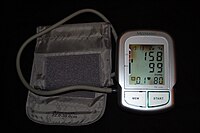
Photo from wikipedia
The simultaneously evaluated plasma K+ levels, serum aldosterone and renin concentration are essential to differentiate the causes of low-renin hypertension (LRH). In case of low renin with low aldosterone levels,… Click to show full abstract
The simultaneously evaluated plasma K+ levels, serum aldosterone and renin concentration are essential to differentiate the causes of low-renin hypertension (LRH). In case of low renin with low aldosterone levels, a broad spectrum of monogenic disorders such as apparent mineralocorticoid excess, glucocorticoid remediable aldosteronism, Liddle syndrome, hypertensive forms of congenital adrenal hyperplasia, and Gordon syndrome (familial hyperkalemic hypertension, pseudohypoaldosteronism type II, PHAII) are among the likely etiologies [1, 2]. If plasma K+ is markedly increased, the differential diagnosis narrows to Gordon syndrome (low-normal serum aldosterone concentration). Therefore, hyperkalemic metabolic acidosis and LRH with normal aldosterone in our patient directed our diagnosis to Gordon syndrome. WNK1, WNK4, and CUL3 gene defects which can cause Gordon syndrome were screened (Illumina Miseq platform using Nextera XT library preperation kit, Illumina Inc., USA). Analysis of the CUL3 gene revealed heterozygous novel c.1395 + 4A >G mutation in our case compatible with Gordon syndrome.
Journal Title: Pediatric Nephrology
Year Published: 2019
Link to full text (if available)
Share on Social Media: Sign Up to like & get
recommendations!